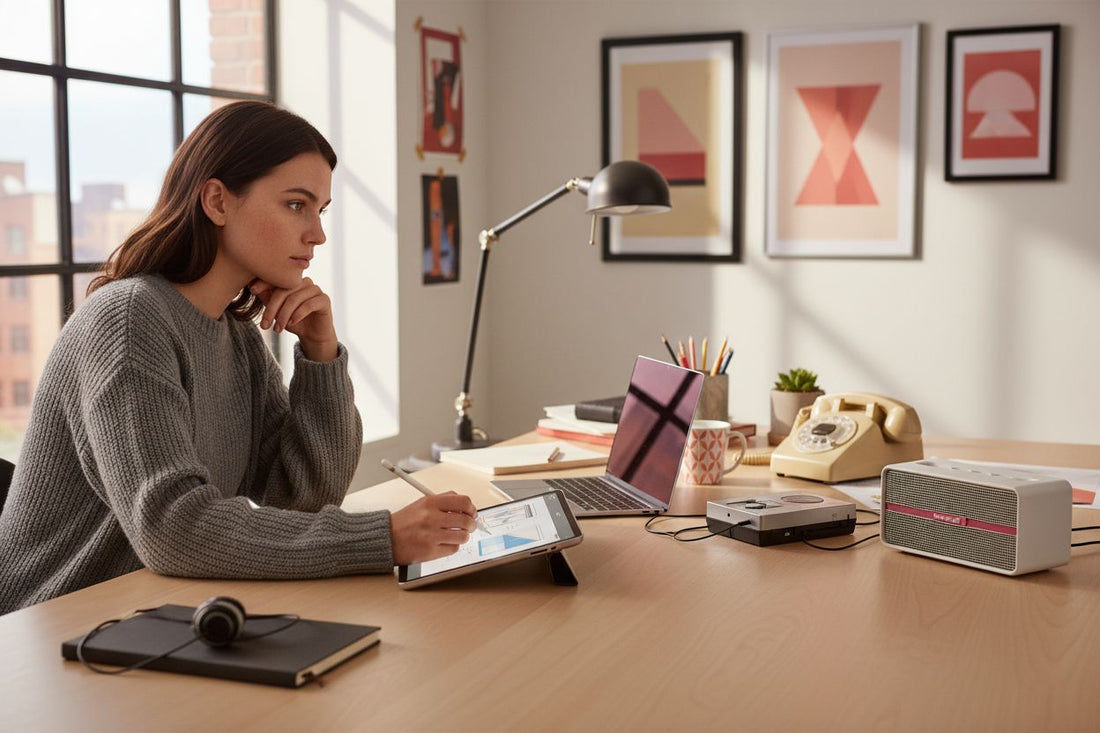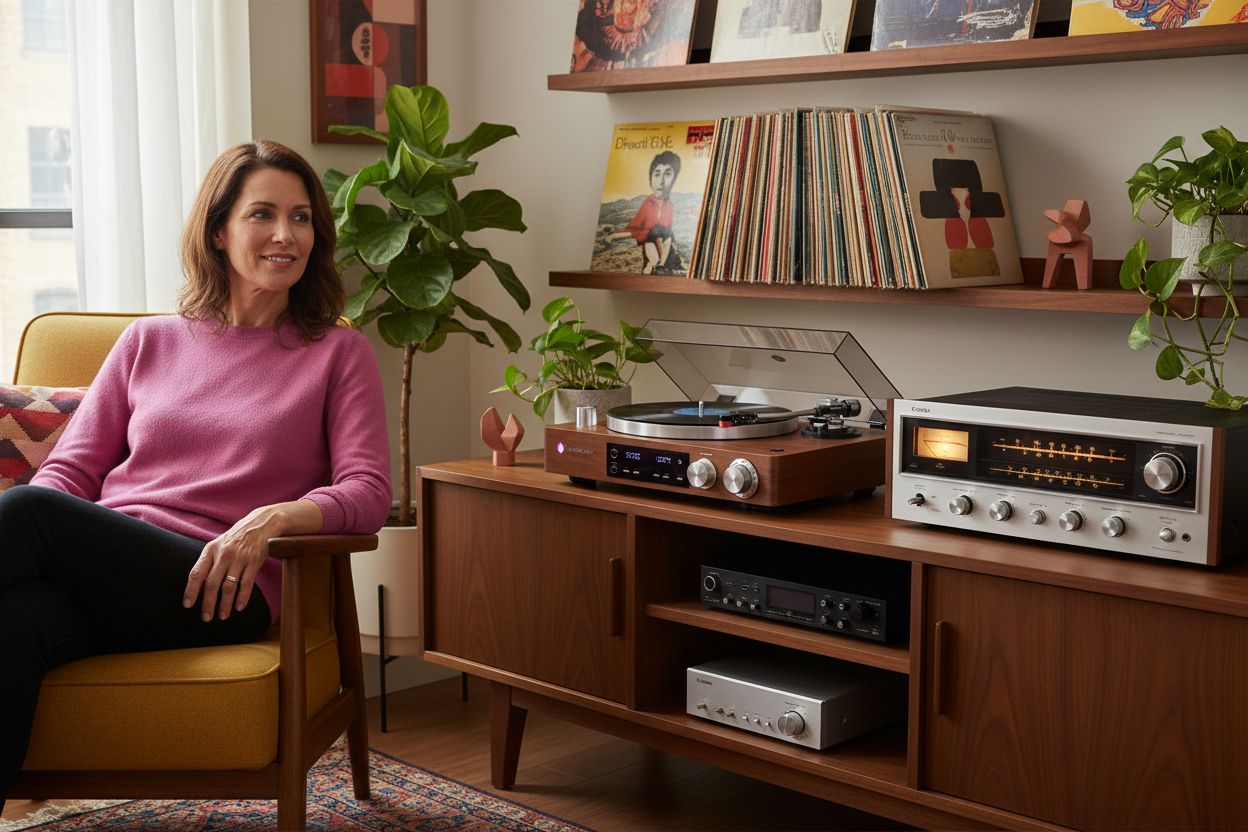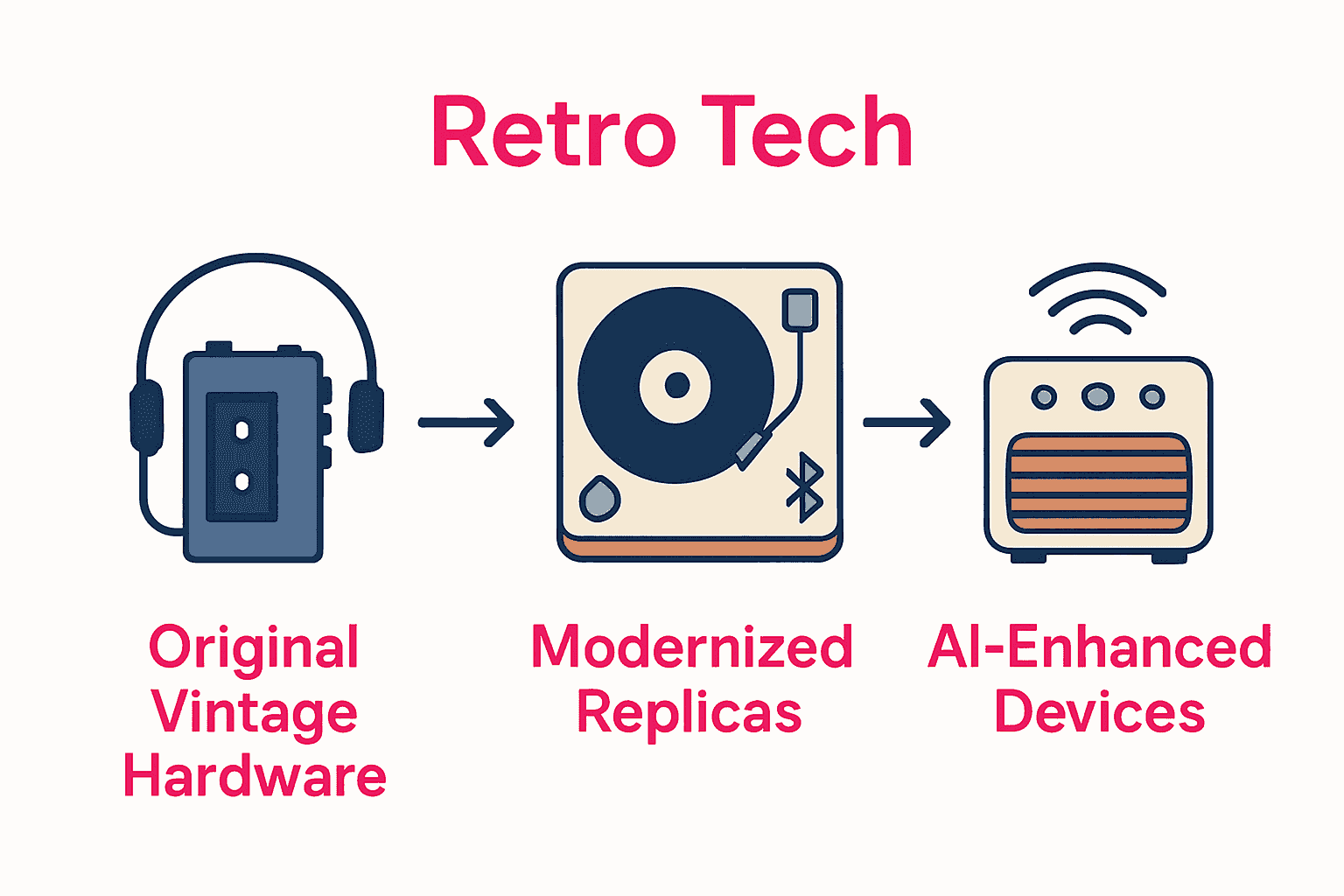
What Makes a Gadget Retro: Complete Guide
Share
Did you know that over 60 percent of adults feel nostalgic when they see technology from their childhood? This strong pull to the past is shaping the way designers create modern gadgets that look and feel like classic devices. Retro tech is more than just a vintage revival, it’s a fresh blend of old-school style and up-to-date features. Discover how this thoughtful balance brings familiar comfort back into everyday technology.
Key Takeaways
| Point | Details |
|---|---|
| Definition of Retro Gadgets | Retro gadgets combine nostalgic design with modern functionality, reflecting specific historical aesthetic principles while integrating contemporary technologies. |
| Nostalgia in Design | Nostalgia drives current design trends, offering emotional comfort and authenticity, which appeals to consumers amid rapid technological changes. |
| Authenticity Challenges | Buyers must be wary of mass-produced imitations; authentic retro gadgets require careful research to ensure quality and provenance. |
| Balancing Form and Function | Effective retro tech must maintain usability without sacrificing aesthetic appeal, achieving a balance between the allure of nostalgia and practical performance. |
Table of Contents
- Defining Retro Gadgets And Core Concepts
- Key Characteristics Of Retro Devices
- Types Of Retro Tech: Classic To Modern
- How Nostalgia Influences Design Trends
- Common Pitfalls When Buying Retro Gadgets
Defining Retro Gadgets And Core Concepts
A retro gadget isn’t just an old piece of technology - it’s a carefully crafted modern object that captures the nostalgic essence of past design eras. According to research on retro style, these objects consciously evoke past aesthetics with an unsentimental approach, blending technological functionality with emotional resonance. Discover more about retro tech trends that showcase how contemporary designers reimagine historical technological styles.
The core concept of retro technology goes beyond mere reproduction. It’s about creating new devices that deliberately reference design languages from specific historical periods - typically from the late 20th century. These gadgets aren’t simply replicas but modern interpretations that capture the visual and emotional spirit of past technological moments. Think sleek devices with rounded edges, vibrant colour palettes reminiscent of the 1980s, or minimalist interfaces that echo mid-century modern design principles.
Key characteristics that define a retro gadget include:
- Deliberate aesthetic references to past technological eras
- Modern functionality integrated with vintage design elements
- Emotional connection through nostalgic visual cues
- Reimagined technologies that celebrate historical design languages
While retrocomputing often focuses on preserving actual vintage hardware, retro gadgets represent a more nuanced approach - creating new technologies that pay homage to historical design while delivering contemporary performance. These devices aren’t just about looking backward; they’re about creating a dialogue between technological past and present, allowing users to experience a sense of familiar comfort combined with cutting-edge innovation.
Key Characteristics Of Retro Devices
Retro devices stand out through their unique aesthetic design language that deliberately references specific historical technological periods. According to research on retro style, these devices employ derivative design elements from recent decades, combining emotional familiarity with contemporary functionality. Explore the fascinating world of retro accessories to understand how designers reimagine technological nostalgia.
A hallmark of retro technology is its commitment to visual storytelling through design. Retrotronics exemplifies this approach, featuring electronics built using older components like vacuum tubes or Nixie displays specifically chosen for their aesthetic qualities rather than pure performance. These devices aren’t merely technological artifacts but narrative objects that communicate cultural memory and design evolution.
Key characteristics of retro devices include:
- Intentional color palettes reminiscent of specific historical periods
- Distinctive shape language referencing vintage technological designs
- Integration of traditional materials with modern manufacturing techniques
- Visual elements that trigger nostalgic emotional responses
The magic of retro devices lies in their ability to bridge technological generations. They’re not just about looking backward, but creating a sophisticated dialogue between past and present design philosophies.
 By carefully balancing historical references with contemporary functionality, these devices offer users a unique technological experience that feels simultaneously familiar and innovative.
By carefully balancing historical references with contemporary functionality, these devices offer users a unique technological experience that feels simultaneously familiar and innovative.
Types Of Retro Tech: Classic To Modern
Retrocomputing encompasses a fascinating spectrum of technological experiences, ranging from preserved vintage hardware to modern reimaginings of classic devices. According to research, this field includes both original obsolete hardware maintained in functioning condition and contemporary recreations that capture the essence of historical technology. Explore the fascinating world of retro style trends to understand how designers are bridging technological eras.
The landscape of retro tech can be categorized into several distinctive types. Classic Restoration involves maintaining or meticulously restoring original vintage devices, preserving technological artifacts from specific historical periods. Modernized Replicas represent another fascinating category, where contemporary manufacturers create new devices that closely mimic the design language and aesthetic of past technological generations, integrating modern functionality with nostalgic visual cues.
Key types of retro tech include:
- Original vintage hardware maintained in working condition
- Modern recreations with historical design inspirations
- AI-enhanced devices with vintage aesthetic elements
- Collectible tech merging analog design with contemporary features
- Emulated technologies that replicate historical computing experiences

Here’s how different types of retro tech compare:
| Type of Retro Tech | Key Features | Typical Example |
|---|---|---|
| Classic Restoration | Original hardware Manual repair Collector value |
1980s home computer Vintage Walkman |
| Modernised Replica | Retro design New tech inside User-friendly |
Bluetooth cassette player Retro gaming console |
| AI-Enhanced Devices | Vintage look Smart features Voice control |
AI-powered radio Nostalgic smart speaker |
| Collectible Tech | Limited edition Mix of analogue/digital High aesthetic focus |
Designer turntables Artisan Nixie clocks |
| Emulated Technologies | Historical software Runs on modern hardware Authentic experience |
Emulator PCs Classic game emulators |
Modern retro tech trends are particularly exciting, showcasing innovative approaches that blend nostalgia with cutting-edge technology. These devices are not merely reproductions but sophisticated dialogues between past and present technological design philosophies. By reimagining classic communication devices and integrating contemporary technological capabilities, retro tech creates a unique user experience that celebrates both historical design and modern innovation.
How Nostalgia Influences Design Trends
Nostalgia has become a powerful driving force in contemporary design, transforming how we perceive and interact with technology and aesthetics. According to recent research, this phenomenon extends beyond mere sentimentality, representing a sophisticated emotional response to rapid technological change. Explore the fascinating connection between nostalgia and consumer behavior to understand how emotional connections shape design trends.
In South Africa and globally, nostalgic design trends are experiencing a remarkable renaissance. Research indicates that consumers are increasingly drawn to vintage aesthetics that offer emotional comfort and a sense of connection to past eras. Globally, retro tech is gaining popularity by combining vintage aesthetics—such as cassette decks and woodgrain consoles—with modern functionality like Bluetooth streaming, creating a unique blend of historical charm and contemporary convenience.
Key ways nostalgia influences design trends include:
- Providing emotional comfort in a rapidly changing digital landscape
- Offering a sense of authenticity and character
- Creating visual connections to personal or cultural memories
- Countering digital overload with familiar, tangible design elements
- Generating social media appeal through distinctive, recognizable styles
The psychological appeal of nostalgic design goes beyond simple reproduction. It represents a nuanced dialogue between past and present, allowing individuals to reimagine technological experiences through a lens of emotional resonance. By integrating vintage design elements with modern functionality, designers create products that are not just technologically advanced, but also deeply meaningful and personally significant.
Common Pitfalls When Buying Retro Gadgets
Authenticity remains a critical challenge for retro tech enthusiasts navigating the complex market of vintage and vintage-inspired devices. According to research in the South African market, buyers face significant sustainability and authenticity concerns, with many retro pieces being mass-produced knock-offs that lack genuine quality. Learn how to protect yourself from counterfeit products to ensure you’re investing in genuine vintage or high-quality retro tech.
The environmental and functional trade-offs of retro gadgets present another significant consideration for potential buyers. Research indicates that while second-hand shopping can be sustainable, vintage tech may often be unreliable or challenging to repair. Modern recreations, designed to capture nostalgic aesthetics, sometimes compromise core functionality in favor of visual appeal, creating a delicate balance between form and performance.
Common pitfalls when purchasing retro gadgets include:
- Purchasing mass-produced imitations instead of authentic pieces
- Overlooking potential repair and maintenance challenges
- Prioritizing aesthetic appeal over functional reliability
- Failing to verify the device’s genuine provenance or manufacturing origin
- Underestimating potential hidden restoration or maintenance costs
Successful retro tech acquisition requires a nuanced approach that balances emotional appeal with practical considerations. Buyers must develop a critical eye, thoroughly researching potential purchases, understanding the device’s historical context, and realistically assessing its long-term usability and potential maintenance requirements. The most satisfying retro tech experiences come from informed, thoughtful selections that honor both the device’s historical design and contemporary functionality.
Discover Genuine Retro Gadgets With Confidence
After reading our complete guide on what makes a gadget retro, you probably feel both inspired and cautious. Authenticity and emotional connection are at the heart of retro tech, but the market is full of mass-produced imitations and confusing options. If you are searching for devices that capture true nostalgic design while offering modern functionality, OnlyRetro provides peace of mind for every enthusiast.
Browse the curated collection at OnlyRetro and enjoy products that are selected for their genuine retro aesthetic and reliable performance. Whether you want to explore the latest retro tech trends or need protection for your vintage-inspired devices, our platform brings you the best of both eras. Ready to embrace authentic nostalgia? Visit OnlyRetro today for a shopping experience where every product tells a story.
Frequently Asked Questions
What characteristics define a retro gadget?
Key characteristics of a retro gadget include deliberate aesthetic references to past technological eras, modern functionality with vintage design elements, emotional connections through nostalgic visual cues, and reimagined technologies that celebrate historical design languages.
How do modern retro gadgets differ from classic restoration?
Modern retro gadgets are contemporary recreations that mimic the design language of past technologies while incorporating modern functionalities. In contrast, classic restoration focuses on preserving original vintage hardware in working condition, maintaining the essence of the historical device without modern updates.
What are the common types of retro technology?
Common types of retro technology include original vintage hardware, modernized replicas, AI-enhanced devices that feature a vintage look, collectible tech that blends analog design with contemporary features, and emulated technologies that replicate historical computing experiences on modern hardware.
How does nostalgia influence design trends in retro gadgets?
Nostalgia influences design trends by providing emotional comfort, creating visual connections to personal or cultural memories, and offering authenticity. Designers integrate vintage aesthetics with modern functionality, appealing to consumers looking for familiarity in a rapidly changing digital landscape.